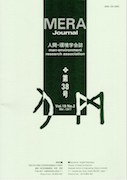Volume 3, Issue 2
Displaying 1-11 of 11 articles from this issue
- |<
- <
- 1
- >
- >|
-
Article type: Cover
1997Volume 3Issue 2 Pages Cover1-
Published: January 20, 1997
Released on J-STAGE: October 01, 2018
Download PDF (19K) -
Article type: Index
1997Volume 3Issue 2 Pages Toc1-
Published: January 20, 1997
Released on J-STAGE: October 01, 2018
Download PDF (23K) -
Article type: Article
1997Volume 3Issue 2 Pages 1-11
Published: January 20, 1997
Released on J-STAGE: October 01, 2018
Download PDF (1505K) -
Article type: Article
1997Volume 3Issue 2 Pages 13-21
Published: January 20, 1997
Released on J-STAGE: October 01, 2018
Download PDF (1063K) -
Article type: Article
1997Volume 3Issue 2 Pages 23-29
Published: January 20, 1997
Released on J-STAGE: October 01, 2018
Download PDF (774K) -
Article type: Article
1997Volume 3Issue 2 Pages 31-32
Published: January 20, 1997
Released on J-STAGE: October 01, 2018
Download PDF (359K) -
Article type: Article
1997Volume 3Issue 2 Pages 33-34
Published: January 20, 1997
Released on J-STAGE: October 01, 2018
Download PDF (255K) -
Article type: Article
1997Volume 3Issue 2 Pages 35-39
Published: January 20, 1997
Released on J-STAGE: October 01, 2018
Download PDF (606K) -
Article type: Appendix
1997Volume 3Issue 2 Pages App1-
Published: January 20, 1997
Released on J-STAGE: October 01, 2018
Download PDF (20K) -
Article type: Cover
1997Volume 3Issue 2 Pages Cover2-
Published: January 20, 1997
Released on J-STAGE: October 01, 2018
Download PDF (22K) -
Article type: Cover
1997Volume 3Issue 2 Pages Cover3-
Published: January 20, 1997
Released on J-STAGE: October 01, 2018
Download PDF (22K)
- |<
- <
- 1
- >
- >|
